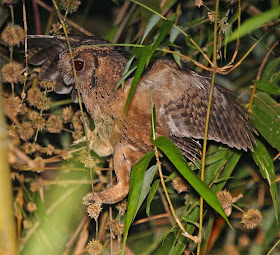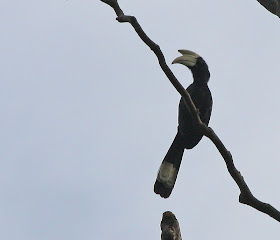
Black-shouldered Kites do very well in oil palm estates, especially if there are sufficient trees left in which to nest. They are the commonest raptor, but beautiful nonetheless!

At night, our surveys usually reveal a healthy population of Barn Owls.

Spotted Wood Owls are even more evident, being the most commonly recorded owl in the estates, though mostly along the fringes.

They are usually pretty approachable!

Buffy Fish-Owls are much less common, and always in the vicinity of streams, drains or rivers.



Collared Scops Owls are more often heard than seen, but we got lucky with this one. We also heard Reddish Scops, Oriental Bay and Brown Wood Owls, and Gould's and Javan Frogmouths, but these were too elusive to photograph.

The commonest mammals recorded on our night-time surveys are usually Common Palm Civets. Any mammal spotted off the ground is likely to be this species.
A pair of eyes in the lights on the ground could also belong to a civet, or a feral dog, cat or cow, but I always hope they'll reveal my favourite night survey species - a Leopard Cat!

This adult seemed unperturbed by our presence.

...And we were able to watch this delightful half-grown kitten going on a hunting foray.

This big (male?) one seemed a lot more reserved.

Evidence of Wild Boar incursion is usually very obvious, but we rarely get chance to observe the culprits on the scene!

By day, the mammals we see are usually squirrels of various species, and this time we recorded the impressive Black Giant Squirrel.

Red Junglefowl, the ancestor of our domestic chook, are plentiful and relatively easy to observe.

Around the staff quarters we observed three myna species. This photo shows a Jungle Myna (left), distinguished by the blue bill base and whitish belly, with a Javan Myna (right), distinguished by the evenly grey underparts down to the vent. We observed mixed flocks of these two taxa. This is interesting, as Javan (a feral invasive species spreading from the south) has tended to displace or genetically swamp Jungle wherever it colonizes. Javan were recorded from this area from 2001 and, 7+ years later, Jungle still seems to be holding its own.

A group of Jungle Mynas.

The only evidence of hybridization we saw was this bird, which we identified as a Common x Javan Myna, on the basis of the yellow facial skin (Common) and slate-grey belly (Javan).

Hill Mynas aren't really related to the other mynas at all. These hang on in the estates along fringes with forest reserves, and take advantage of tall trees left standing within the estates to build their nests in a hole in the trunk.

A small number of species live in the forested areas but make use of the oil palm fruits as an alternative food source. One is the Blue-crowned Hanging Parrot.

More species survive in the forest reserves along the estate boundaries, such as Black Hornbills...

...and Chestnut-breasted Malkohas.

Oriental Pied Hornbills tend to frequent settlement areas where there are ornamental fruiting trees.

Tiger Shrikes are typical forest fringe migrants.

Wetlands offer the chance of surprises, even when they are well inland. This Watercock had made a temporary home in the settlement ponds.


An interesting bird to finish with. I've seen juvenile Barn Swallows with white throats before, but this is the first time I've seen one apparently in adult plumage.
Striking pictures of the kite, owl and leopard cat. Well done!
ReplyDeleteThanks Tony,
ReplyDeleteThat was quick feedback!
Hi Dave,
ReplyDeletere the Barn Swallow, i guess that any Barn Swallow in February that shows such strong contrast between two generations of coverts & primaries (with very brownish and abraded older ones)and a white throat should be a 2cy bird.
cheers, pim
Brilliant owl shots there! Seems like they're doing well in oil palms!
ReplyDeleteHi Dave,
ReplyDeleteThe night bird photos are great, but the Leopard Cat is the star !
John,
H.K.
Couldn't agree more John! I don't normally like cats, but these kitties are the biz!
ReplyDelete